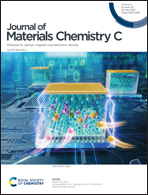Boosting ppb-level triethylamine sensing of ZnO: adjusting proportions of electron donor defects†
Abstract
As effective active sites for gas sensing, defects have been widely studied in recent years. However, reasonable regulation of defects in semiconductor metal oxides for gas sensing is a formidable challenge, and wide application of defect engineering still has limitations. Here, we synthesized ZIF/Zn(OH)m as precursors through annealing treatment, and obtained ZnO species with different defect ratios of donors. The gas-sensing tests displayed outstanding sensitivity (at the ppb level) and fine selectivity towards triethylamine at 275 °C with high electron donor ZnO, which was attributable to the donor-rich defects (zinc interstitial, Zni, and oxygen vacancy, VO) and higher adsorption energy of oxygen. The donor-related defects, as characterized by spectral measurements, reduce the band gap (determined from UV-visible and density functional theory (DFT) calculations), and enlarge the carrier concentration and electrical conductivity. Meanwhile, the enhanced adsorption capacity of oxygen (calculated by DFT) is conducive to the formation of more ionized oxygen. Our findings suggest that a defect molding strategy in metal oxides provides the possibility to improve the performance of gas sensors.

- This article is part of the themed collection: Journal of Materials Chemistry C HOT Papers


 Please wait while we load your content...
Please wait while we load your content...